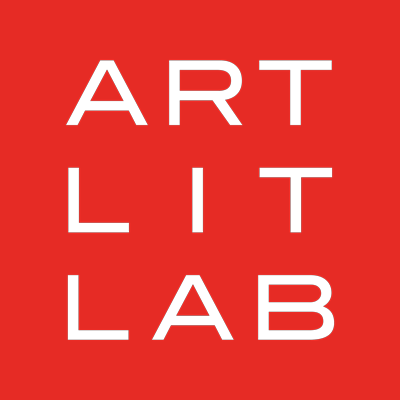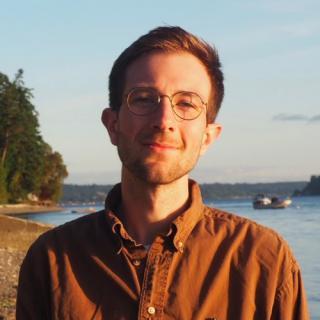ALL Review: A series of titular erasures are braided throughout Meltwater, which together present an astonishing lyric meditation on ecological collapse and what such a collapse means for cultural memory, for language. Could you tell me a bit about what draws you to erasure and its significance in the book? I’m also curious about how the practice of erasure influenced your writing practice more broadly. Has it changed the way you approach the blank page?
Claire Wahmanholm: I do think that erasure has affected how I think about poem-making, especially since I started thinking about erasure (at least the way I approach it) as a collaborative mode. I think about other forms this way too—golden shovels, terminal poems, found poems obviously, acrostics, even abecedarians to some extent. Sometimes it’s collaboration with a literary lineage, or a particular writer, and sometimes it just feels like collaboration with a pre-existing structure. Every time I write in those modes, I’m inviting a relationship. So the blank page is now populated by a potential for interconnectedness rather than an isolated endeavor. I’ve also been thinking a lot about abundance and generosity in poetry, just as I’ve been trying to reorient my thinking that way in my non-poetry life. I’m trying to approach everything with a community-oriented abundance mindset rather than an individual scarcity mindset: there’s absolutely enough in the world already; why not work with what’s already there rather than working from scratch? (I mean, what’s a “new” or “original” poem anyway?)
My approach to erasure has always been more akin to close reading—more like an attention to the language that’s already there—than it is a confrontational exercise. The texts I’m drawn to (Sagan’s Cosmos in Wilder, Theocritus’s Idylls and Virgil’s Eclogues in Redmouth, and Lacy M. Johnson’s article in Meltwater) are so rich, so capable of telling so many stories in addition to the ones on their surface, which is what close reading is all about. In the case of the Meltwater erasures, I was interested in highlighting my own tendency to frame things within the context of my children, which on the one hand feels selfish when the story is a global one, but on the other hand, we’ve gotten into so much existential, ecological, humanitarian trouble by refusing to acknowledge that we have skin in the game.
AR: I was struck by how Meltwater grapples with motherhood in the Anthropocene. As ecosystems are disappearing and extinctions are accelerating, loss always already takes center stage. “Even you are made of / vanishing, new as you are,” the speaker of “Glossary of What I’ll Miss” says to their daughter. Could you speak to the phenomenon of grieving environmental loss and the loss of potential futures for new generations?
CW: Grief is absolutely my jam, but lately I’ve been trying to do it differently. I am trying to grieve better, which involves reorienting my imagination away from worst case scenarios (which is my default). I’m trying to release my cynicism and make room for repair and redemption. I’ll admit that I’m not very good at it yet. In “Starling” we see the consequences of living in terror, which is that the speaker passes it like a poison on to her unborn child, who doesn’t survive. I don’t want that. I don’t want to show these poems to my children and be like, “Look at what you missed! The world was so much better before you got here!” How could that be true? I want them to feel as much joy as possible as early as possible, which means I need to feel it too. We’ll all need to have a reservoir of joy if we’re going to have the energy to turn the ship around.
AR: Many of the poems in Meltwater center non-human actors, with appearances from a range of species—everything from oarfish to zebra finches. The speaker of “In a Land Where Everything Is Trying to Kill You, I Teach You to Be an Autotomist” even turns to “the lizard whipping its tail free, the spider unhinging itself / from two of its legs” for instructions on survival. Every instance in which an animal appears is handled with precision and care. What does it mean to you to include an animal in one of your poems? What considerations go into that?
CW: I really wanted to be as specific as possible with the animals and plants that appear in Meltwater. If we see poems—and books of poems—as miniature worlds, I want those worlds to be richly populated as a sort of resistance to the people who would see it diminished, only in service to humans, excavated down to nothing for our own purposes. I see specificity as an ethical practice. My knowledge of the natural world is not exhaustive, which meant I was constantly looking things up and learning about new (or very old) species and deferring to a knowledge that wasn’t my default. The poem-writing often felt like a way of diminishing the personal in favor of the communal/collective. It felt like expansion and potential. If we can’t have in-the-flesh moments of encounter with the more-than-human world (or if those moments are becoming increasingly rare), poems can maybe step into that space and enact a diffusion of boundaries between worlds, a collapsing of distance and time.
AR: The ending of that poem—“In a Land Where Everything Is Trying to Kill You, I Teach You to Be an Autotomist”—is absolutely devastating. “When I look / toward the stars, I find myself squinting to anchor them onto the sky. But I am alive / to notice the dullness. I am alive to notice the blood / running less redly beneath the flies.” These lines—and the book—seem to argue for attending to the still-vibrant world while recognizing the limits of that attention, the toll of knowing the meltwater is deepening and feeling it, too. I wonder how you think about poetry’s role in the Anthropocene. Is it our job as poets to imagine potential futures, to make the consequences of, say, rising sea levels not only known intellectually but also experienced viscerally, to awaken readers to the tolls these crises would inflict on one’s psyche and one’s body?
CW: Short answer, yes! I do think that’s what the best ecopoetry strives to do. “Autotomist” is an interesting poem to point to: in it, the speaker has achieved the ability to detach the vulnerable, hurting parts of herself, which she has always longed to do. The benefit is that she is able to survive in a dangerous, annihilating world. But it comes at a price, of course, which is a numbness to what is still wonderful and electric and life-sustaining. The speaker is imagining an ideal world where this trade-off doesn’t have to be made, where her children can be safe and still feel connected to the world. But it’s not possible. This is what I had been struggling with before I had children: my own impulse is toward self-protection, numbness, safety from pain. But once I had them, this obviously became impossible, and navigating this new world is the major theme of Meltwater.
AR: There are so many intertextual conversations braided through Meltwater. W.H. Auden, Inger Christensen, Alicia Jo Rabins, and Gjertrud Schnackenberg, among others, appear in epigraphs to various poems. Would you share a bit about the unseen artifacts that influenced this book, be it the influences of other poets, visual artists, films, or other media?
CW: Beneath the surface, I’d say fairy tales play a pretty big role, as they did in Wilder. The poems “Hunger” (“Little Red Riding Hood”), “Metamorphosis with Milk and Sugar” (“Hansel and Gretel”), and “Poem that Cries Wolf” (“The Boy Who Cried Wolf,” of course) are all fairy tale-inflected. I wanted to show that these struggles are very old, and our hungers haven’t really changed; that parenthood has always been both sweet and dangerous, its dangers perennial as well as mythic. The last two “Meltwater” poems reference Sappho’s fragment 16, which is a love poem—a rejection of the epic/martial mode in favor of the lyric/domestic/intimate. The whole Meltwater sequence shows, hopefully, what happens when we align ourselves with extractivist, individualistic tendencies rather than the intimate. In terms of visual art, the scale of Olafur Eliasson’s climate work can’t be replicated in poems, but I was imagining that the “Glacier” series, if they existed in the real world, might look something like his work. The “Glacier” that begins "Zero degrees" was inspired by the real-life Svalbard Global Seed Vault.


